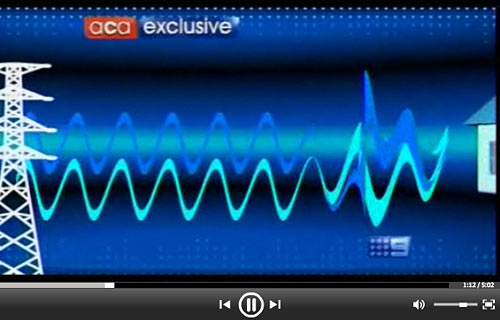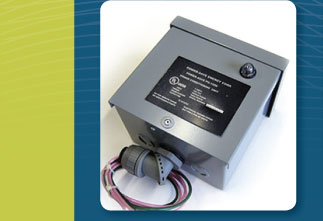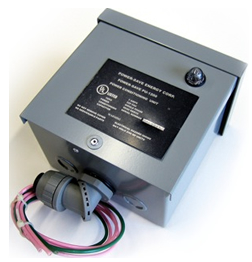Thanks, once again, to all you readers and your ceaseless campaign to make me sad and irritable, I now know that a couple of days ago that jewel in Australia's investigative-reporting crown, A Current Affair, ran a story about yet another bloody "power saver".
You can see the five-minute ACA segment here.
(Pleasingly, as I write this, the comments on that page are overwhelmingly negative. I've only clicked the "10 more comments" button a couple of times, but thus far it's the sanest comment thread I've ever seen on a mainstream-media site.)
This latest magic electricity talisman is the "Oz Power Saver", the Web site for which is immensely proud of the ACA story, but oddly bereft of further information. You can't even buy one. All you can do is "register your interest".
The basic claims on the site are par for the energy-saver course, though. "Save up to 25% off your electricity bills", "reduces energy usage", and the inevitable "guarantee".
That ACA video fills in the rest of the blanks, with the same stuff we've seen over and over from other magic-box salesmen.
Like the guarantee, for instance, which this time says that they'll refund the purchase price if you don't save at least the Oz Power Saver's purchase price in three years.
It would be churlish and tendentious of me to point out that scam-gadgets, definitely including "power savers", almost always have alleged money-back guarantees, and that power-saver hucksters have a tendency to spawn new businesses rather more frequently than once every three years.
So I shall, of course, not point that out.
On goes the video, dum de dum, it's "already a huge hit in the US and Europe", here's a testimonial from the "one lucky family" in all of Australia who've had the chance to try the thing out, here's no testimonial from anybody equipped to test it properly, "big energy users like factories and hotels have been using this technology for years"... all right, I reckon we're ready for an atrociously mangled explanation of power factor, and power-factor correction, now.
Ah, there it is.

The ACA explanation actually starts out well, with a double-sine-wave depiction of the voltage/current phase relationship, but then spears off into the bushes with some gibberish about the phase relationship getting messed up as the electricity "travels to your home". (Later on, they tell us that the further you are from a distribution transformer, the worse your power will be.)
It's actually reactive loads that mess up power factor, not the length of wire between your house and a pole-pig transformer. But, more importantly, the people who worry about power factor are the suppliers of the electricity, not its consumers.
To try to get my umpteenth repetition of this lecture out of the way as quickly as possible:
1: There are many, many "power saver" products on the market. Most are little plug-in things, but there are also versions like the Oz Power Saver that are hard-wired in the breaker box. Actually, there are some that're very, very like the Oz Power Saver, to the point of looking exactly the same, as we'll see in a moment.
2: There is no known way for devices like this to work. Power-factor correction is a real thing, but it is completely impossible for it to save a domestic power consumer any money at all, even if their house has a lousy aggregate power factor, which it almost certainly doesn't.
3: The reason why it can't save you any money is that domestic (and most commercial) power consumers aren't billed for a bad power factor. Domestic (and most commercial) power meters can't even detect a bad power factor. Promoters of these gadgets always come up with some sort of tortured pseudoscientific word-salad that suggests that your electricity meter actually measures the "bad electricity" or "dirty power" or whatever that the magic box cures, but this is not actually the case unless you're running a factory full of motors, and it's not always the case even then.
Back to the Oz Power Saver.
I applied the terrifying black-hat hacker firepower of the TinEye image search to...

...this picture of the product, on the Oz Power Saver site. Whaddayaknow, there was the same image...

...being used on numerous sites selling the good old Power-Save 1200!
Now, the Oz Power Saver can't be the exact same thing as the Power-Save 1200, because the Power-Save 1200 is a US product, and Australia's mains voltage is twice that of the USA.
(Well, OK, it could be the exact same product, if it contains auto-sensing multi-voltage circuitry, or no circuitry at all, which latter situation turns out to be not far from the truth for certain products in this market sector. I don't think either is likely in this case, though.)
One quite marked difference between the Oz Power Saver and the Power-Save 1200 is price. The Power-Save 1200 is about a $US300 product, while the Oz Power Saver, according to the cheerful distributor in the ACA story, revels in a price of eight hundred and ninety-five Australian dollars, which is about the same number of US dollars, as I write this.
But it's guaranteed to save you at least that much in three years, et cetera et cetera.
In the ACA-story demonstration of the Oz Power Saver's incredible qualities, we get to see the traditional Wooden Partition with Wires and Motors On It, and the similarly traditional Cheap 'N' Dodgy Power Meter (sometimes replaced by one or more $10 multimeters) giving its imaginative impression of the power factor of a load.
The demo load manages to achieve a truly miserable power factor of 0.39 according to said meter, which leaps to 0.87 when the Oz Power Saver's activated.
These power-factor numbers may actually be accurate, since the test load appears to be a free-spinning unloaded AC motor, which can be counted on to have a crappy power factor. AC motors that're matched passably well to their load, like most AC motors in the world, can be expected to have a much better power factor. Power tools - electric drills, angle grinders - may have a lousy PF when they're spinning free, but you'll have to spend rather a lot of time standing there grinning at a free-spinning drill bit for that load to make any significant difference to your residence's aggregate power factor.
More realistically, washing machines and tumble-dryers may sometimes have lousy power factor, because different loads of washing mean different loads on the motors. But you'd, again, have to do rather a lot of washing for this to make a significant difference to your home's aggregate power factor, and even if you do, it won't cost you any more money, because residential customers aren't billed by power factor. (Just in case you forgot that.)
Shortly after the cheap-electricity-meter demo, A Current Affair's piece on the Oz Power Saver suddenly switches to an update on a story from last year, about some blokes who make a whole different power-saving thingy, the "Futurewave Energy Saver". Which I immediately, of course, assumed would be another box of pure uncut pixie dust. But which I suspect is actually kosher.
The Futurewave device is alleged to reduce the power consumption of swimming-pool pumps, and some other similar motors. It isn't a magic power-factor box, though; it's a speed-control device, that according to the FAQ saves actual real power, instead of confusedly-described apparent power, by just running the pool pump at reduced speed for most of the pool-cleaning cycle, when full power isn't actually required.
This seems as if it might actually work. I don't know if it does, but it seems to have no arguments with the laws o' physics, or of electricity billing.
Next, the ACA story whiplashes back to the Oz Power Saver, and cheerfully informs us that the Oz Power Saver will "do the same" for "anything with a motor".
So presumably you'd be a total idiot to buy the Futurewave product, that only works for pool pumps.
God, I'd be irritated if I were the Futurewave people. It'd be like taking the time to build a comfortable and safe 80-mile-per-gallon car, and then finding yourself lost in a vast mob of hucksters selling cars that run on water.
I'm not holding my breath for a regulatory agency to do anything about the Oz Power Saver. It is, for a start, not actually on sale yet, and the regulators are overworked and understaffed. Scams that don't actively kill people often don't get a very high priority.
Here, to cheer us all up a bit, is the Australian government slapping down one of the many plug-in power savers, called the Enersonic Power Saver, which I mention here and here.
The Australian Consumers' Association were so impressed with another plug-in power saver, the "Reegen Micro-Plug" that they gave it a Shonky Award. And here are those nice people who sold one of these things until they realised it was a scam, then said sorry. They, along with some non-Australian examples are mentioned at the end of this old post.
My offer from the end of that post still stands. If the Oz Power Saver people want to contact me about installing one of their boxes at my house, preferably with a nice Frankenstein knife switch so I can switch it in and out of the circuit at will just as they do in their demo, I will test it with various household motor loads and will immediately recant all of the above if the Oz Power Saver turns out to do a damn thing.
2 February 2011 at 10:32 pm
You learn something every day.
Today I learned about tineye - looks like a cool gadget.
3 February 2011 at 12:25 am
Early this week Today Tonight ran a story in the east about the Earthwise power saver - another PFC device. The following night, TT in Perth ran a story on the very same product.
But, the product had essentially been debunked in a follow-up on TT-east before the Perth program went to air. I guess WA consumers don't need that sort of cynicism thrust before them while they're eating dinner.
Jan 31 Story in eastern states
http://au.todaytonight.yahoo.com/article/8749468/consumer/power-saver
Feb 1 Follow-up eastern states
http://au.todaytonight.yahoo.com/article/8756894/consumer/power-saving-ideas
Feb 1 WA story
http://www.7perth.com.au/view/today-tonight-articles/today-tonight-power-device/
Oh, and please, please check out "Panacea University", home of one of the "experts"...
http://www.panaceauniversity.org/about.htm
Warning: take your tinfoil hat with you on that tour!
3 February 2011 at 10:07 am
Yes, you need to cover the TT one too. After you've had a good nap and a stiff drink - you must consider your health.
3 February 2011 at 11:02 am
Wow. I think I'd save more power with the FREE power saving magic box that Origin Energy just sent me!
"What?" I hear you say. Yes that's right. Origin sent out a free remote controlled power board that allows me to shut down all my AV equipment with the TV remote.
To me that's the real magic box. I had a bad habit of leaving my AMP, sub, xbox, ps3 etc on all the time. I'm looking forward to seeing the difference in my bill.
So if you want a magic box to save you power. Try something like that instead. It's a lot more likely than these snake oil devices.
(and thanks Dan for keeping the bastards honest, or at least giving it a damn good try)
4 February 2011 at 12:59 pm
This power saving device is also being discussed the Whirlpool forums. I had been in contact with Fair Trading (NSW) but it seems they might not do anything about it.
http://forums.whirlpool.net.au/forum-replies.cfm?t=1631059&p=3
We seriously need an expert to talk to Fair Trading or the govt agencies to stop these scams.
4 February 2011 at 7:05 pm
ACA has now run a story exposing the scam.
4 February 2011 at 7:22 pm
I contacted WA Fair Trading too, just to ask if they had an opinion on the TT story/advert/product. They don't get involved without either a complaint or a mention by the Commissioner. So I contacted Media Watch.
7 February 2011 at 1:29 pm
Peripherally related:
A plug-in gas saver that does all this (including converting units of power into units of relative portion measurement), glows a pretty blue colour, and doubles as an anal plug!
I wonder if your metabolic rate would see some improvement with it stuck up your arse.
It would surely reduce emissions in this configuration, one would suppose.
11 February 2011 at 9:41 am
The article is now removed from the ACA Site: http://aca.ninemsn.com.au/article.aspx?id=8204229
"The Article contents are unavailable"
19 February 2011 at 10:05 pm
Wow, Australia is responsible for A Current Affair?
Neat. I didn't know that.
All this time I thought my own country was responsible for most of the world's really terrible television programming. If A Current Affair isn't our fault, that makes me feel a little better about my country. My day has been brightened, thank you.
I don't suppose Australia would be willing to take credit for Jerry Springer also? (Yeah, didn't think so.)
24 February 2011 at 3:01 pm
That Futurewave device looks like a soft-start automatic variable speed control. Small centrifugal pumps, as used for swimming pool filters, are pretty inefficient to start with, because of their size. Still, I'd expect them to be set up to work near their 'best efficiency point'. Slowing them down is likely to reduce the efficiency, and although less electricity is being consumed, even less work is being done by the pump. (Thermodynamics wins again.) Your filter won't work as well as it should. It would be like putting a smaller motor on the pump. If that worked, why are the pumps as big as they are in the first place?
The Futurewave site FAQs also say the device will work on three phase motors. Impressive, but how?
17 March 2011 at 5:18 am
The article about EULAs on the other site was fascinating. Great read.
18 March 2011 at 8:58 am
OK, you post something like that last column over on DansData then you really gotta open up a comment thread to match it over here. OK, so no, you don't have to, but it would be nice! ;)
So, I can generally agree with your conclusions (that a free market of creative works can flourish) but I don't buy Wikipedia as evidence. Why? Well, because of the first corollary to that basic law of humanity (People are bastards.) which says this : All things being equal - bastards are also usually lazy.
This makes Wikipedia not a good example. To truly screw Wikepedia up you have to exert an unreasonable amount of energy. You have to actually work at it... and most people just won't do that. It's just like most folks who use Wikipedia never actually contribute a singe word to it. Wikipedia has 78 million unique visits a month and 91,000 contributors (per http://en.wikipedia.org/wiki/Wikipedia:About). That means that 0.116% of the user population is contributing. Wikipedia's griefers exist in that 91,000 people... these are the remarkable bastards. The ones who care enough about their own twisted viewpoint or juvenile pleasure to actually spend the time putting it out there only to be quashed over and over again. I submit that a large portion of the other 78 million visitors are quite likely bastards in their own right... but they are simply too lazy to figure how to do anything at all with Wikipedia besides settle bar bets.
So, in short, Humanity is generally speaking a bunch of bastards... but they are lazy bastards. The passionate people who will tend to take action (any action - from editing Wikepedia to donating to an artist for their work) are typically a bit less bastardly than the average person so, on the whole, things work out.
1 September 2012 at 11:13 pm
I know it's been like forever, but I feel the need to chime in that the vast majority of US Homes DO have 240V electricity coming into them and that dohicky looks to be designed to plug onto a box such as what the circuit breakers are housed in. We generally use 240V power for high energy devices like stoves, water heaters, and dryers. After that, outlets are on what's known as a split-phase system that essentially attempts to put half the house in series with the other half, all moderated by the ground(known as 'neutral'.
2 September 2012 at 10:52 am
Yes, this is true, but I'm pretty sure the Power-Save 1200 is sold as being a ~120V device. These instructions, for instance, don't mention 240V anywhere. Some Power-Save 1200 sellers seem to say the domestic versions works with 110/120 and 220/240 simultaneously, or something; I'm sure the salesmen say it gets all the problems away for the whole house.
If it follows the usual template of not having any actual functional circuits inside at all, it may indeed be equally compatible with all voltages.